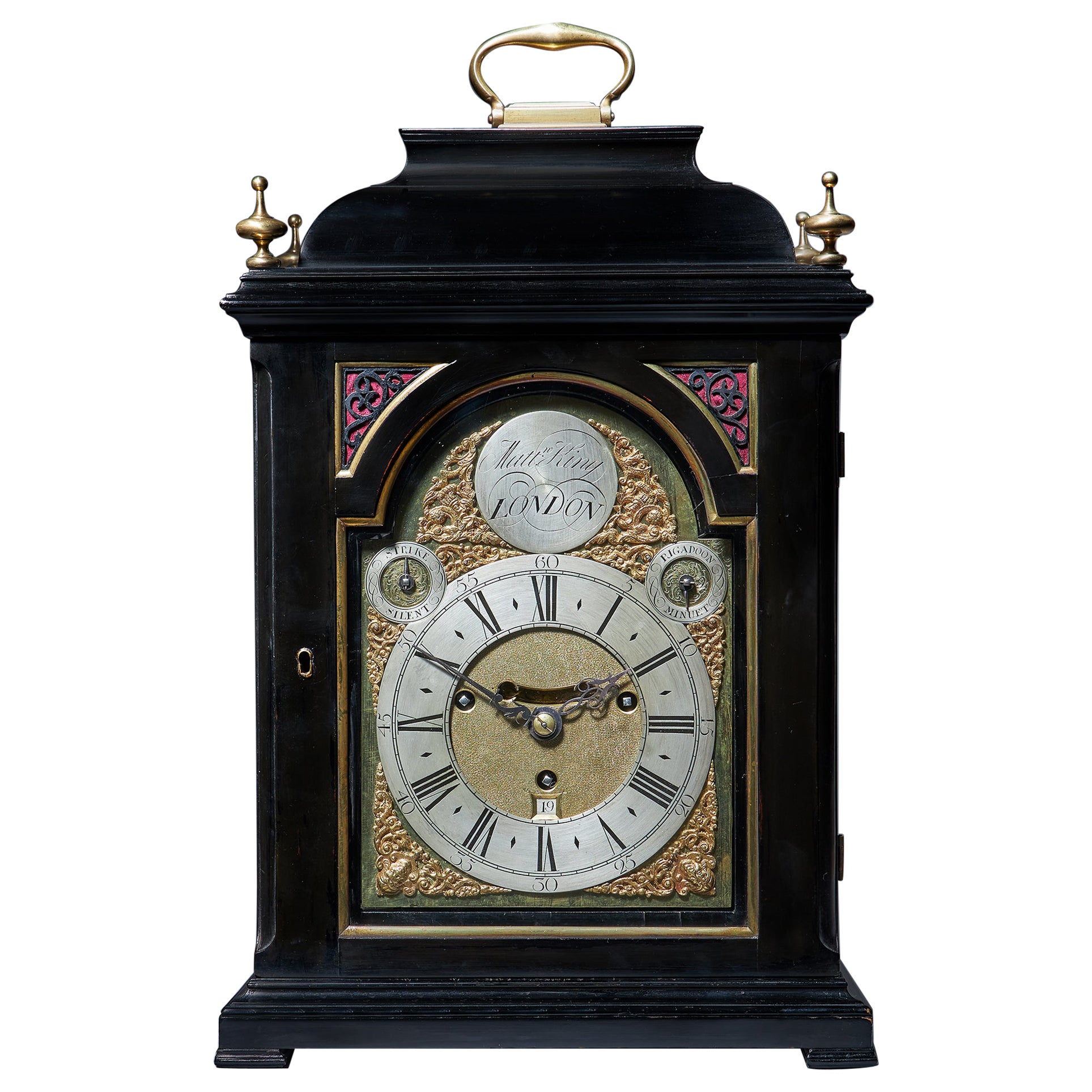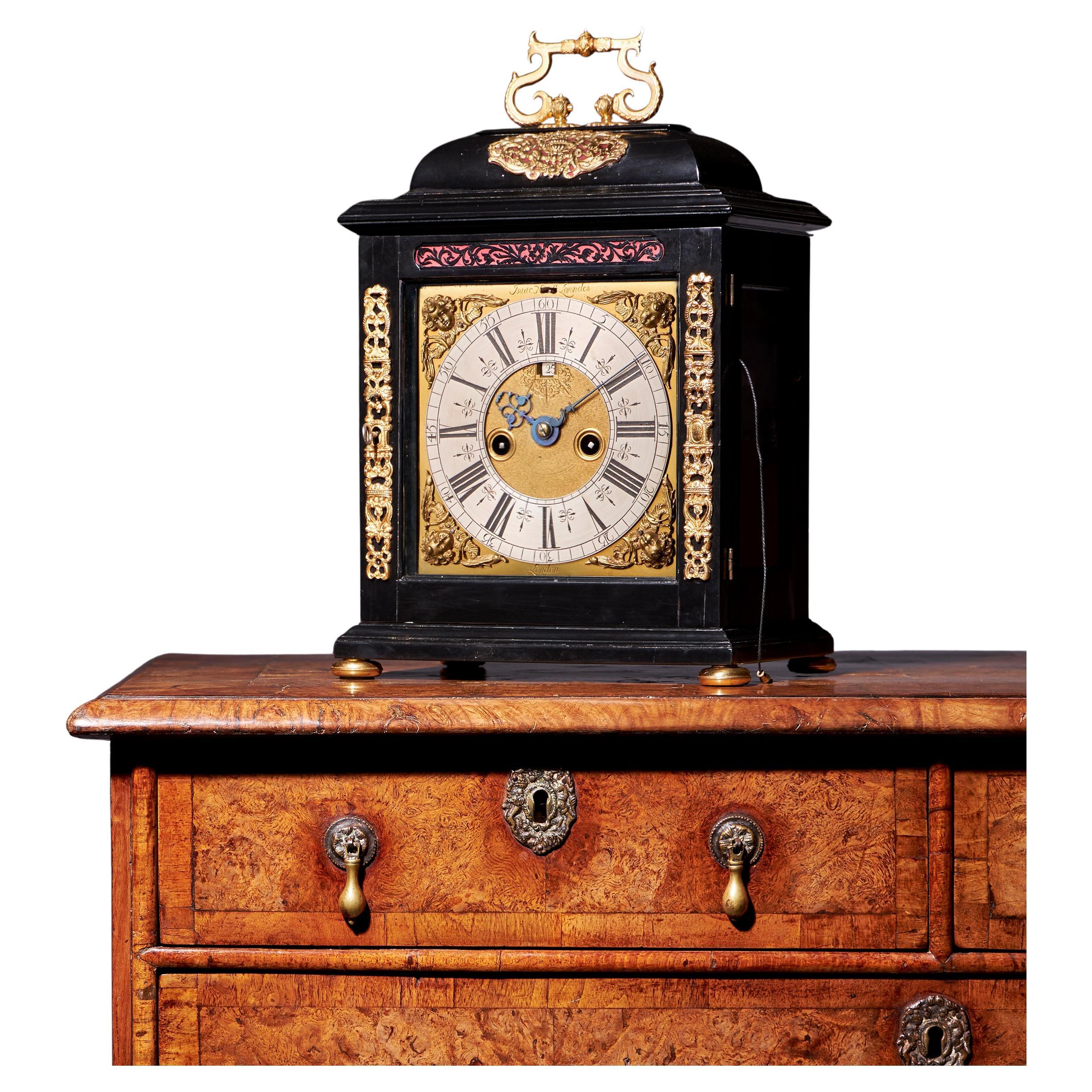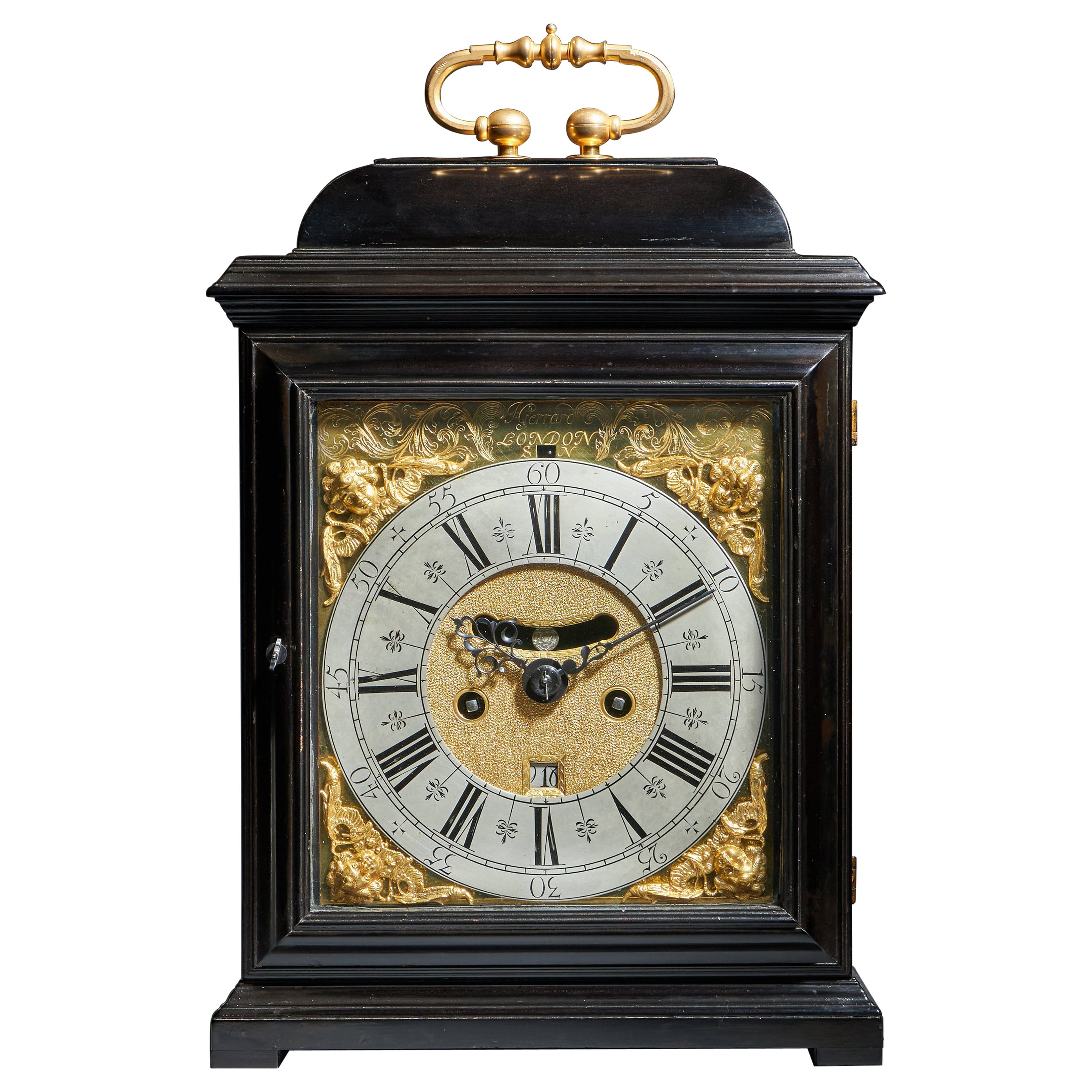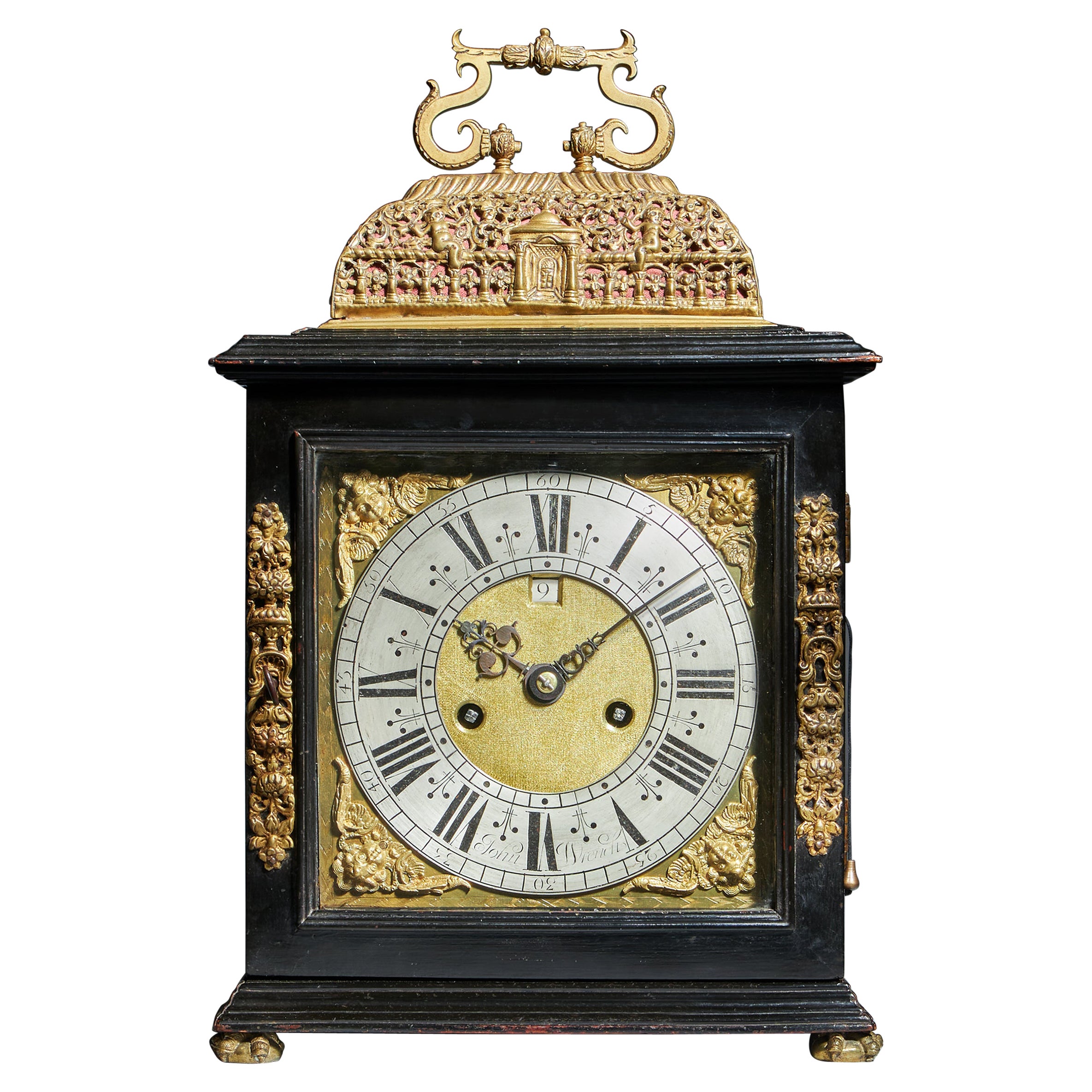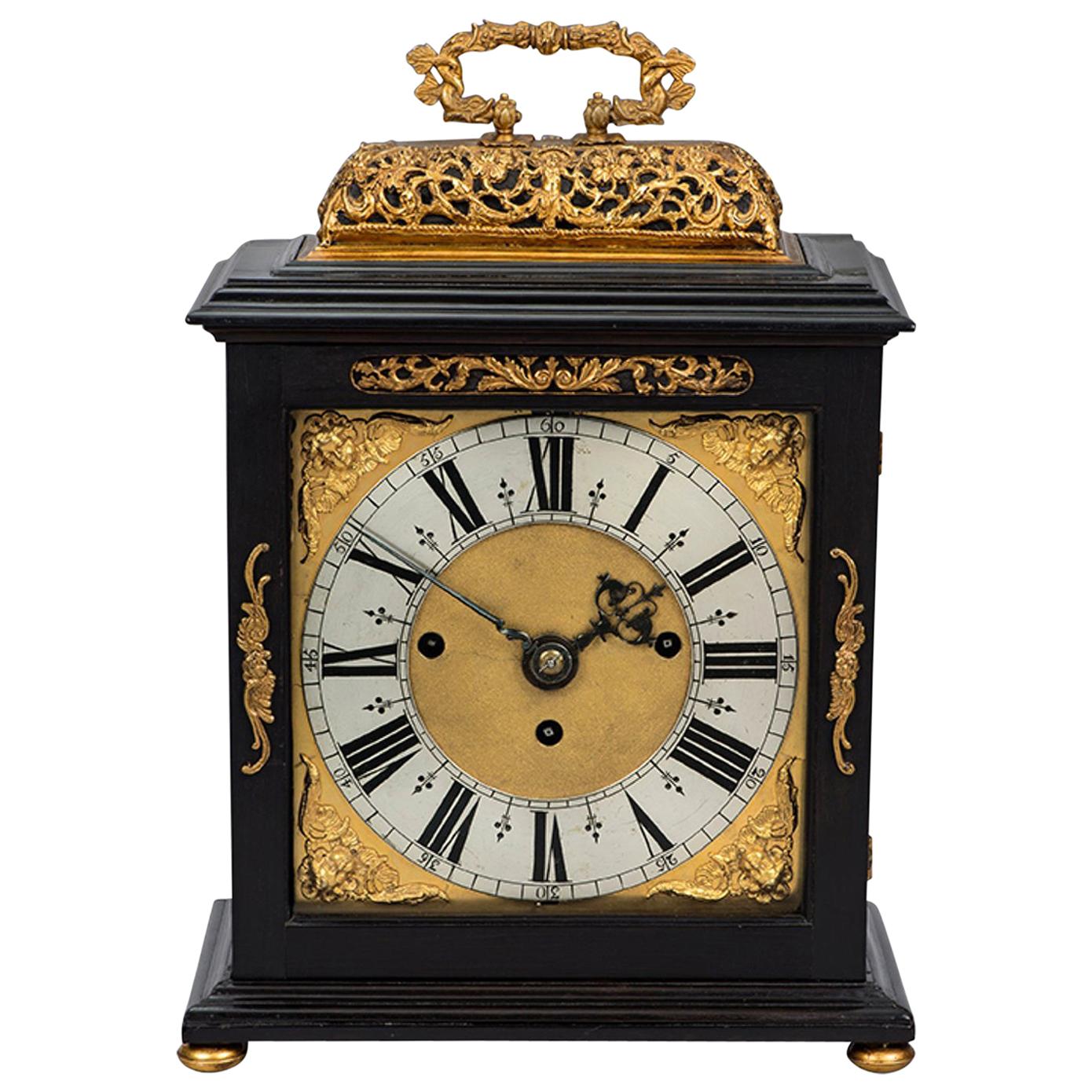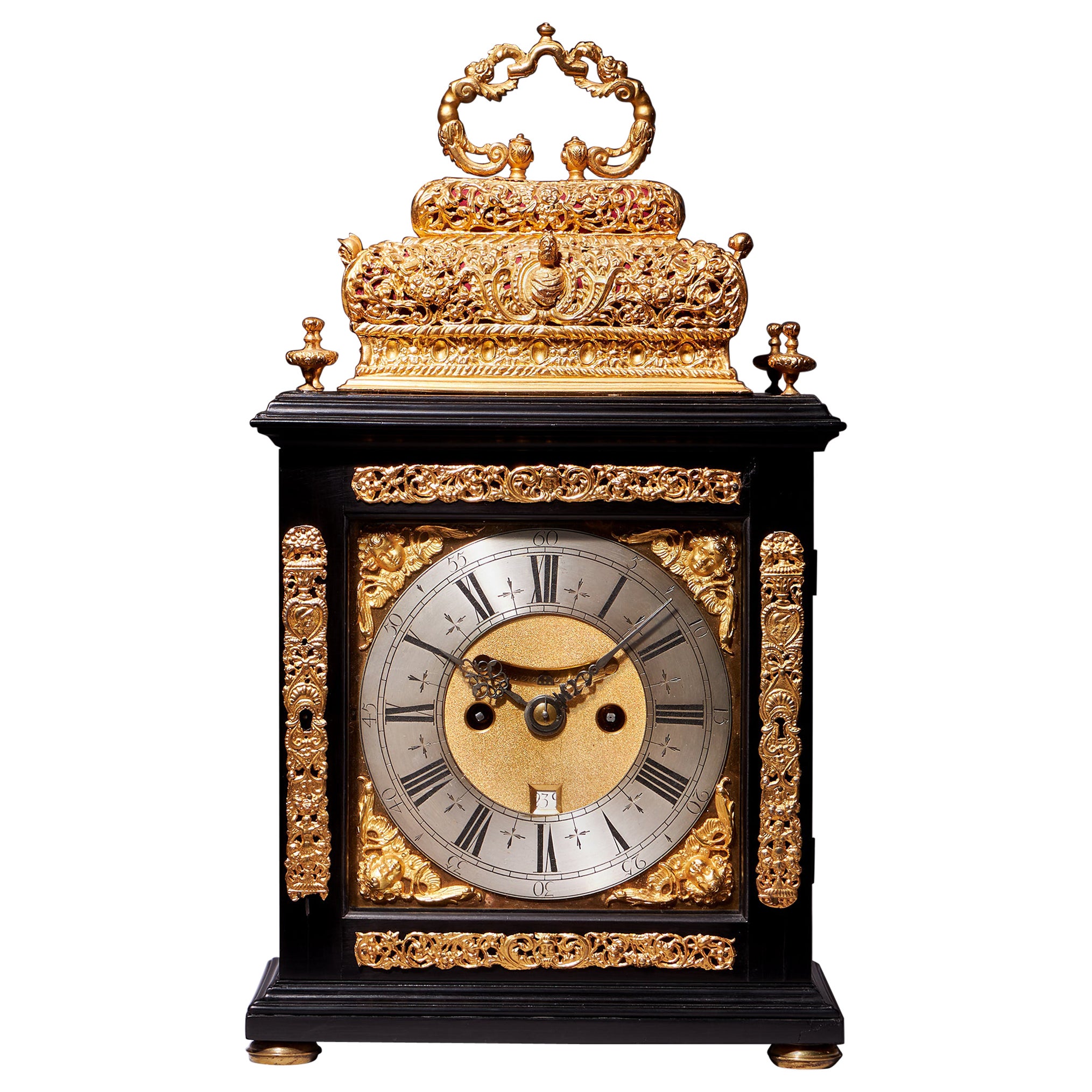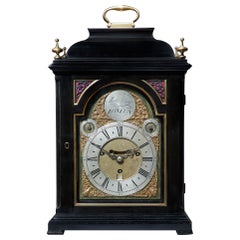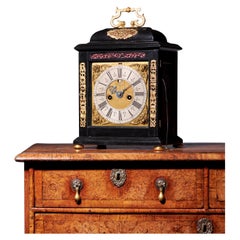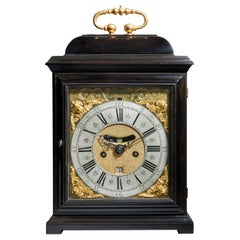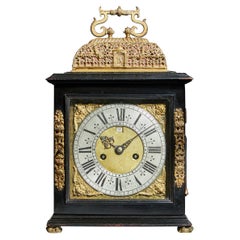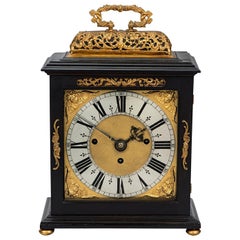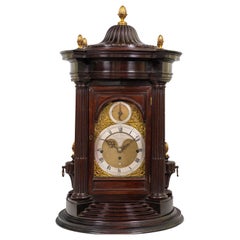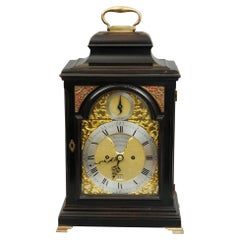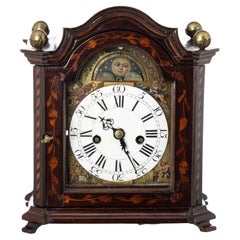Items Similar to A Rare and Important Charles II 17th Century Table Clock by Henry Jones
Want more images or videos?
Request additional images or videos from the seller
1 of 12
A Rare and Important Charles II 17th Century Table Clock by Henry Jones
$114,088.55
£85,000
€98,611.99
CA$160,300.12
A$175,764.26
CHF 91,884.64
MX$2,105,116.38
NOK 1,159,105.49
SEK 1,087,241.11
DKK 736,692.62
About the Item
The Rare and Important 17th Century Spring Driven Table Clock by the Celebrated Maker, Henry Jones.
Provenance dating back to 1745. Owned by Captain Alexander Raitt
A very rare and unusual Charles II English eight-day spring-driven table clock signed on the backplate, Henry Jones in the Temple, dating back to the period c.1675-80.
The elegantly proportioned ebony-veneered oak basket top case, whose austerity goes straight back to East-style models, has extremely shallow mouldings and large rectangular viewing windows to the sides so that the movement is almost entirely visible. The case rests on four brass bun feet.
The fine square brass dial with matted centre and just winding holes has an applied silvered chapter ring and winged cherub-head spandrels in the corners. The chapter ring is engraved with a narrow outer minute ring within which are Arabic five-minute numerals and two different types of 7½-minute markers, a central ring with Roman hours I-XII and fleur-de-lys half-hour markers and an inner ring divided into quarter hours. The time is indicated by an elegant pair of finely pierced period blued steel hands. Above the XII is a strike/silent aperture with original switch.
The striking eight-day twin fusee brass movement, with six latched pillars, early fusees with open click work and verge escapement with a short knife-suspended pendulum. The striking, which is regulated by an internal rack, indicates the hours fully on a bell. The backplate shows the pre-setting ratchet wheels with typical clicks and a fine U-shaped click spring. It is profusely engraved in period style around a typical signature cartouche with the maker’s name: Henry Jones in the Temple. The movement has an unusual bar operated pull-quarter repeat on two bells differing in pitch, one for the quarters and the other the hour bell.
The maker
Henry Jones was born at Boulder near Southampton in 1634 and was apprenticed to the famous maker Edward East in 1654 through the Clockmakers’ Company. He was made free in 1663 but remained working for East until 1672, when he set up in the Inner Temple. Later he was recorded in the Inner Temple Lane. He was a prolific maker, his work being highly thought of. Apart from spring, lantern and longcase clocks, he also made watches.
Literature:
B. Loomes, The Clockmakers of Great Britain 1286-1700, Ashbourne, 2014, pp.430-31.
B. Loomes, Watchmakers and clockmakers of the World, London, 2006, p.429.
Provenance
This clock is known as the Alexander Raitt clock. It was shipped from Scotland to America by Captain Alexander Raitt in 1745, sailing his own ship. Captain Raitt settled in Kittery in the province of Maine of the Massachusetts Bay Colony. On October 2, 1747, he married Miriam Frost (1722-1807), widow of Eliot Frost, a daughter of the Honourable John Frost of New Castle, New Hampshire.
The house where the Raitts lived is still in a good state of preservation in Kittery, now Eliot. It was built by Eliot Frost, Miriam’s first husband in 1740.
The clock, descending from father to son since it was brought over from Scotland and has been in the Raitt family until it was acquired by Miss Elizabeth Mehitable Bartlett of Eliot who presented it to her brother Ralph Sylvester Bartlett in 1939. It was still in his possession in 1941. It later went to his cousin John William Pepperrel Frost, who was the last owner, before we acquired the clock.
- Creator:Henry Jones (Clockmaker)
- Dimensions:Height: 12.6 in (32 cm)Width: 9.06 in (23 cm)Depth: 5.91 in (15 cm)
- Style:Charles II (Of the Period)
- Materials and Techniques:
- Place of Origin:
- Period:
- Date of Manufacture:1675-1690
- Condition:Repaired. Replacements made. Wear consistent with age and use. The repeat work was partly restored to the original pattern. Several missing parts were made in the correct style.
- Seller Location:Oxfordshire, GB
- Reference Number:1stDibs: LU4936237642372
About the Seller
5.0
Recognized Seller
These prestigious sellers are industry leaders and represent the highest echelon for item quality and design.
1stDibs seller since 2019
24 sales on 1stDibs
Typical response time: 1 to 2 days
Associations
LAPADA - The Association of Arts & Antiques Dealers
- ShippingRetrieving quote...Shipping from: Faringdon , United Kingdom
- Return Policy
Authenticity Guarantee
In the unlikely event there’s an issue with an item’s authenticity, contact us within 1 year for a full refund. DetailsMoney-Back Guarantee
If your item is not as described, is damaged in transit, or does not arrive, contact us within 7 days for a full refund. Details24-Hour Cancellation
You have a 24-hour grace period in which to reconsider your purchase, with no questions asked.Vetted Professional Sellers
Our world-class sellers must adhere to strict standards for service and quality, maintaining the integrity of our listings.Price-Match Guarantee
If you find that a seller listed the same item for a lower price elsewhere, we’ll match it.Trusted Global Delivery
Our best-in-class carrier network provides specialized shipping options worldwide, including custom delivery.More From This Seller
View AllRare 18th Century George II Musical Table Clock by Matthew King, circa 1735
Located in Oxfordshire, United Kingdom
A rare George II musical table clock by Matthew King, circa 1735.
This unusual eight-day spring-driven table clock was made by Matthew King, wh...
Category
Antique 18th Century English George II Table Clocks and Desk Clocks
Materials
Silver, Brass
A 17th Century William and Mary eight-day table clock by Isaac Lowndes, 1695
Located in Oxfordshire, United Kingdom
A fine William and Mary eight-day spring-driven table clock signed on the backplate, Isaac Lowndes Pallmall Court, c.1695.
The elegantly proportioned ebony-veneered oak domed top c...
Category
Antique 17th Century English William and Mary Table Clocks and Desk Clocks
Materials
Brass
A rare 17th century English eight-day spring-driven table clock by J Gerrard
Located in Oxfordshire, United Kingdom
A Rare Late 17th Century English Eight-Day Spring-Driven Table Clock, Circa 1700. England
Signed J. Gerrard.
This exceptional late 17th-century English eight-day table clock is a s...
Category
Antique 17th Century English William and Mary Table Clocks and Desk Clocks
Materials
Brass
17th Century English eight-day spring-driven table clock, by John Wrench
Located in Oxfordshire, United Kingdom
A Rare Late 17th Century English Basket-Top Spring Clock by John Wrench of Chester, Circa 1695-1700. England
This exquisite late 17th-century English basket-top table clock, signed ...
Category
Antique 17th Century English William and Mary Table Clocks and Desk Clocks
Materials
Brass
A 17th Century William and Mary eight-day double basket table clock by Asselin
Located in Oxfordshire, United Kingdom
A relatively small and extremely attractive late 17th century English eight-day spring-driven double basket table clock signed on the backplate Asselin London, dating to the period c...
Category
Antique 17th Century English William and Mary Table Clocks and Desk Clocks
Materials
Brass
Fine Ebonized George II Eight Day Table Clock with Dutch Striking and Trip Rep
Located in Oxfordshire, United Kingdom
By the highly regarded maker Andrew Prime.
Andrew Prime, was apprenticed in 1725 and a member of the Clockmakers’ Company in 1736.
The movement is an extremely accomplished pi...
Category
Antique Early 18th Century English Georgian Table Clocks and Desk Clocks
Materials
Fruitwood
You May Also Like
17th Century Antique Ebony and Gilt Table Clock by Edward Burgis of London
By Edward Burgis
Located in Devon, GB
A rare James II ebony and gilt-metal basket-top quarter-striking spring table clock. The latched 7 1/4 inch square dial has a matted centre, silvered and engraved chapter-ring with strike or silent above 'XII'.
The three-train verge fusee...
Category
Antique 17th Century British Jacobean Table Clocks and Desk Clocks
Materials
Brass
18th Century Antique Mahogany Neoclassical Musical Clock by Ralph Gout of London
Located in Devon, GB
An impressive and unique 18th centur,y, GeorgeIII period antique circular mahogany musical table clock, in a case of neoclassical design by Ralph ...
Category
Antique Late 18th Century English Neoclassical Table Clocks and Desk Clocks
Materials
Brass
18th Century Bell Top Bracket Clock by James Evans
Located in Lincolnshire, GB
An elegant 18th century 8 day verge bracket clock in ebonised case by James Evans London.
The back plate beautifully engraved.
The movement has ...
Category
Antique Late 18th Century English Mantel Clocks
Materials
Wood
TABLE CLOCK Dutch, around 1740 18th Cent.Machine marked" J.P. Kroese" Amsterdam
Located in Madrid, ES
TABLE CLOCK
Dutch, around 1740
with mahogany wood case with bronze applications, satinwood inlaid representing vegetal and geometric motifs. Enamelled dial with Roman and Arabic num...
Category
Antique Mid-18th Century Dutch Baroque Table Clocks and Desk Clocks
Materials
Wood
18th Century Antique Mahogany Bracket Clock by Charles Blanchard of London
Located in Devon, GB
A fine antique George II period mellowed mahogany striking bracket clock, the arched brass dial and verge movement both signed Charles Blanchard, London. The clock is standing on block feet, has glazed sides and an inverted bell top with a brass carrying handle.
Literature: Charles Blanchard: 1688-1768 recorded in Baillie 'Watch and Clockmakers of the World, page 29.
Category
Antique 18th Century English George II Mantel Clocks
Materials
Brass
Late 19th Century table clock, made in Stockholm by Auguste Bourdillon
Located in SE
A table clock made in Stockholm by Auguste Bourdillon, 1728- 1799. He were a manufacturer of clocks and watches in Geneva and then in Stockholm 1761 - 1...
Category
Antique 1770s Swedish Rococo Table Clocks and Desk Clocks
Materials
Bronze
More Ways To Browse
Italian Marble Clocks
Digital Clock
Georgian Bracket Clock
Table Pendulum Clock
1920s Art Deco Clock
Antique Table Watch
Art Deco Electric Clocks
Bell Pull
George Bracket Clock
German Alarm Clock
Jaeger Lecoultre Atmos Clock
Jaeger Lecoultre Atmos
Kienzle Table Clock
Small Table Clock
Desk Barometer
Vintage Metal Alarm Clock
17th Antique Clock
French Clock Makers
